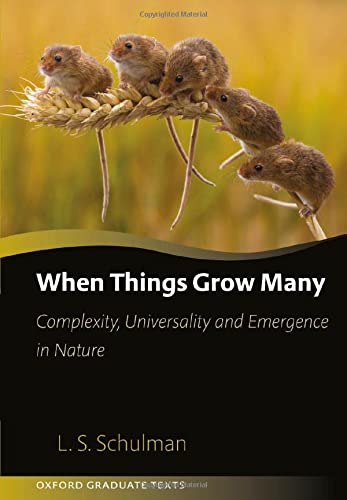When Things Grow Many Complexity Universality and Emergence in Nature 1st Edition by Lawrence Schulman 019260645X 9780192606457
$50.00 Original price was: $50.00.$25.00Current price is: $25.00.
When Things Grow Many: Complexity, Universality and Emergence in Nature 1st Edition by Lawrence S. Schulman – Ebook PDF Instant Download/DeliveryISBN: 019260645X 9780192606457
Full download When Things Grow Many: Complexity, Universality and Emergence in Nature 1st Edition after payment.

Product details:
ISBN-10 : 019260645X
ISBN-13 : 9780192606457
Author : Lawrence S. Schulman
Aimed at advanced undergraduates and graduate students, When Things Grow Many is an accessible and engaging textbook introducing the theory of statistical mechanics, as well as its fascinating real-world applications. The book’s original approach, which covers interdisciplinary applications of statistical mechanics to a wide range of subjects, including chemistry, biology, linguistics, economics, sociology and more, is bound to appeal to a wide audience. While the first part of the book introduces the various methods of statistical physics, including complexity, emergence, universality, self-organized criticality, power laws and other timely topics, the final sections focus on specific relevance of these methods to the social, biological and physical sciences. The mathematical content is woven throughout the book in the form of equations, as well as further background and explanations being provided in footnotes and appendices.
When Things Grow Many: Complexity, Universality and Emergence in Nature 1st Table of contents:
1 Introduction
1.1 Building
2 Ideal gas
2.1 Fluctuations of the ideal gas
3 Rubber bands
3.1 The game
3.2 Analysis
3.3 Simulation
3.4 Independent folk
3.4.1 What actually happens
3.5 How often does the prediction go wrong?
4 Percolitis
4.1 An epidemic model
4.2 Discussion
4.3 Behavior of the order parameter near the critical point
4.4 Approach to equilibrium
4.5 Discreteness and fluctuations*
4.6 Self-organized criticality (SOC): Applications to galaxies and mean field theory
4.6.1 SOC in galaxies
4.6.2 SOC in a mean field theory
4.7 The truth about percolitis
4.8 Abstract percolation
4.9 Percolation applications
4.10 True epidemiology
5 Ferromagnetism
5.1 Curie–Weiss ferromagnets
5.2 Magnetization
5.3 Fluctuations greater than N
6 Maximum entropy methods
6.1 Information
6.2 Maximum entropy
6.2.1 Mathematical details*
6.2.2 Constructing the probabilities*
6.2.3 Using the probabilities
6.3 Using maximum entropy to study Supreme Court voting
7 Power laws
7.1 Power laws are scale free
7.2 Diffusion
7.3 Preferential attachment (the rich get richer)
7.4 Exponential functions of exponential distributions
7.5 Superposition of exponentials
7.6 Critical phenomena and self-organized criticality (SOC)
8 Universality, renormalization and critical phenomena
8.1 The nearest neighbor one-dimensional Ising model
8.1.1 Mean field treatment
8.1.2 Transfer matrix treatment*
8.1.3 Spatial correlations*
8.1.4 Renormalization group treatment
9 Social sciences
9.1 Econophysics
9.2 Stock market bubbles and crashes
9.3 Linguistics
9.3.1 Zipf’s law
9.4 Power laws for cities
9.5 Urban discrimination
9.6 Voter models and elections
9.7 Crowd control
9.8 Traffic
9.8.1 Cellular automaton models of traffic
10 Biological sciences
10.1 Firefly synchronization
10.1.1 Other models for synchronization
10.2 Biorobotics and glass
10.3 Gene distributions
10.4 Flocking
10.5 Kuramoto model
10.6 Ecology
10.7 Neurology
11 Physical sciences
11.1 Power laws for luminescence
11.2 Large scale structure
11.3 Galactic morphology
12 Putting it all together
People also search for When Things Grow Many: Complexity, Universality and Emergence in Nature 1st:
growing complexity meaning
why time complexity is important
what is the worst time complexity
grow in complexity
when things get complicated
Tags:
Things Grow,Complexity,Universality,Emergence,Nature,Lawrence Schulman
You may also like…
Medicine - Medicine & Nursing Reference
The Vasculome: From Many, One 1st Edition Zorina S. Galis (Editor)
Arts - Architecture
Poetry - American Poetry
Romanticism, Hellenism, and the Philosophy of Nature 1st Edition
Politics & Philosophy - General & Miscellaneous Philosophy
Engineering - Environmental
Nourishing Tomorrow: Clean Engineering and Nature-Friendly Living 1st Edition David S-K Ting
Housekeeping & Leisure - Role-Playing & Fantasy Games
Politics & Philosophy












